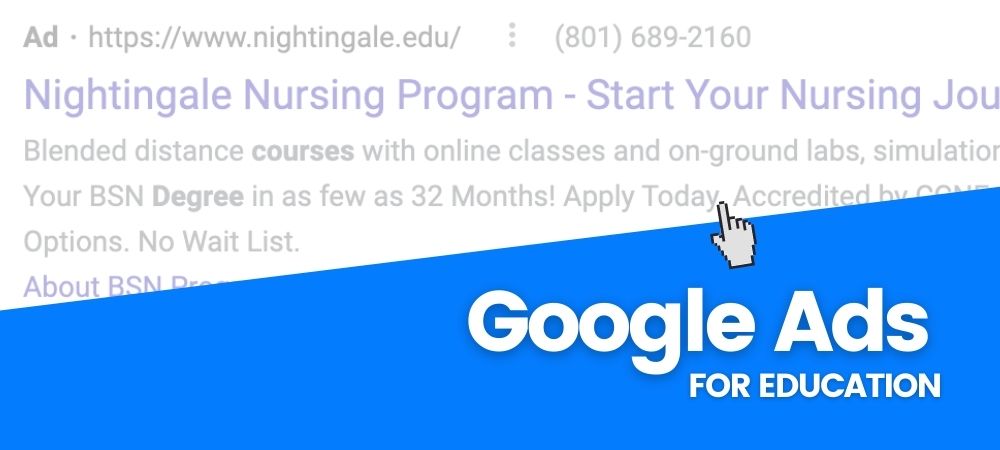Maybe you’ve relied on Google Ads for some time. And it’s working. You’re getting good ROI.
No? Maybe you’ve dabbled. Or possibly, you’re still contemplating taking the plunge.
Then, there are two ways to go: (1) wrestle with the beast yourself or (2) hire a resource who knows how to slay it.
In any and all of the above cases (and combinations), you’re unlikely to elevate your ROI in Google Ads unless you have a decent understanding of what’s what, what works, and what to do when your campaigns are falling short.
The overview I’ve written for you here should deliver some insights and tips you can apply to get a better return on investment from Google Ads.
Google Ads (real quick)
Google Ads is a digital advertising platform businesses use to promote products and services online. Google Ads offers two primary types of content: search ads and display ads.
Search ads are:
- Text-based
- Appear atop (and below) Google search results
- Based on keywords
For an example, check out three search ads from UNC-Chapel Hill, Louisville and Temple University, triggered by the keyword phrase “MBA programs in the Midwest.”
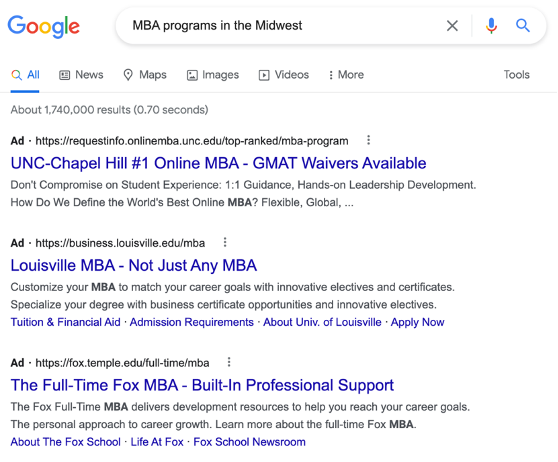
In contrast, display ads are:
- More visual
- Found on websites
- Highly targetable
Display ads appear on over 2 million websites within the Google Display Network, which comprises 90% of the entire Internet population, according to Higher Education Marketing Solutions.
Visitors from display are earlier in the conversion cycle than your Search visitors (who actively search for what you offer).
SOURCE: KLIENTBOOST
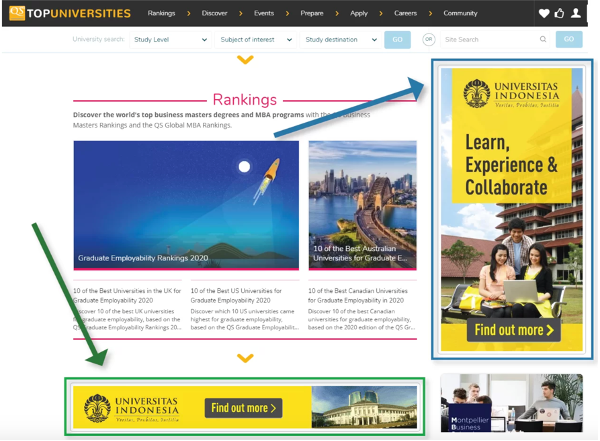
Here you see display ad examples by Universitas Indonesia. Each ad is branded and highly visual, appearing on Top Universities’ rankings webpage. Source: Education Marketing Solutions
How to create smart search ads
Write super strategic copy
Ad copy should clearly speak to your target audience’s needs and motivations. Carefully choose what to highlight, as search ads are limited to 300 characters of text.
Student personas are a key resource, offering insight into different students’ expectations. Take American University’s (AU) Online MBA search ad for example:

AU knows prospective online MBA students are especially interested in three things: learning Python, career advancement, and time efficiency. AU highlights these elements in the ad description, using concise and action-oriented copy.
Use Google Ad extensions
Extensions are extra links that promote additional information, like phone numbers or web pages. Google extensions help boost visibility on search result pages and increase an ad’s clickthrough rate.
Common extensions include:
- Call buttons
- Location information
- Links to parts of a school’s website
- Links to marketing assets, such as program brochures
Extensions are free and can be added in your Google Ads account. Manual extensions require setup; automated extensions are managed by Google.
Choose your keywords wisely
Keywords are words or phrases used to match ads with common search terms. You can add keywords during campaign set-up, or after an ad launches.
Consider what students search for when researching schools. When selecting keywords, helpful questions might include:
- What credentials are students seeking?
- Do students prefer a specific geographic location?
- What program criteria do students prioritize?
Use a tool like Google Ads Keyword Planner to evaluate a potential keyword’s search volume. Search volume helps determine which keywords are most popular—and effective. Additional research may also inspire new keyword ideas.
Specify your audience
Carefully consider the intended audience. The more targeted your audience, the greater likelihood your ads will reach quality prospects.
For search ads, Google offers several demographic targeting options, including:
- Age
- Gender
- Household income
- Parental status
Advertisers can select a combination of criteria in Google Ads. You can also target prospects based on location.
Best practices for creating display ads
Customize your content
Google offers several types of display ad options, including:
- Static image ads
- Rich image ads, which include interactive or animated elements
- Video ads on YouTube
- Text ads
Display ads are visual-based, allowing for more customization—and creative autonomy—than search ads. Schools can also leverage display ads for college branding.
Consider customizing ads with elements like:
- Your schools’ color palette logo and typeface
- On-brand photography
- Branded GIFs

The Universitas Indonesia display ad (as a sidebar) uses the school’s brand colors and typeface, and a photo of students on campus. The ad also includes action-oriented copy and a call to action.

The UK-based Warwick Business School’s display ad (as a banner) uses the WBS logo and brand colors, as well as the school’s characteristic color gradients.
Include CTAs
Make sure to include a call to action (CTA). CTAs reinforce an ad’s primary purpose—driving conversions—by inspiring prospects to click.
CTAs should be:
- Actionable (even urgent)
- Easy to understand
- Easy to find/see/click
Universitas Indonesia and Warwick Business Schools’ ads above go with a simple but smart “Find out more” call to action.
Make sure to link your CTA to a landing page and include a form to capture prospects’ contact details. Landing pages can help generate leads and encourage the next step in the admissions journey.
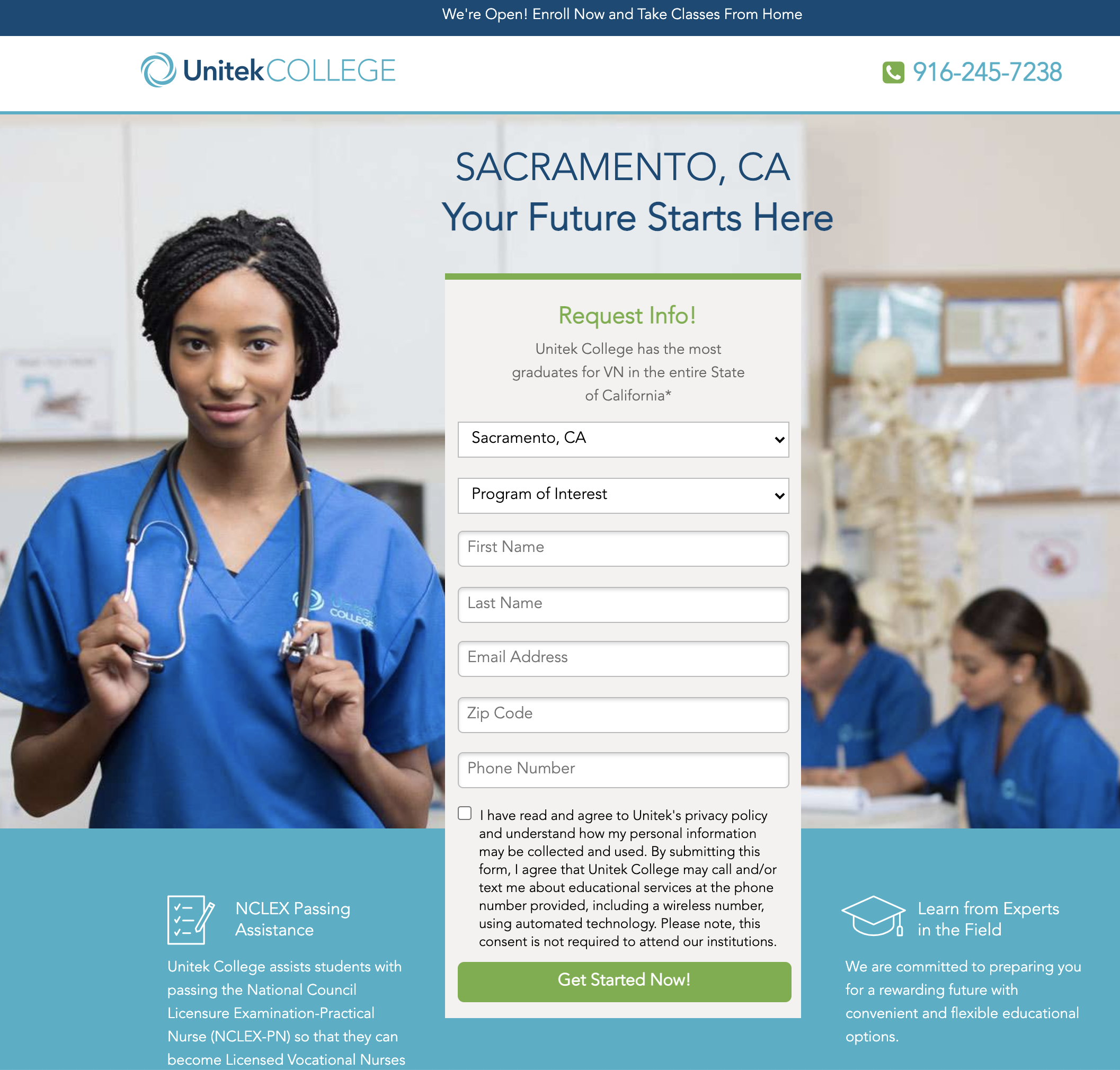
Evaluate your targeting options
Display ads offer a greater variety of targeting options than search ads. Audience targeting options include:
- Lifestyle, based on prospects’ online behavior
- Placement, based on user-identified websites
- Contextual, based on sites automatically selected by Google
- Retargeting, based on prospects with demonstrated interest
Try mixing and matching options in Google Ads. Monitor your ad’s performance and optimize by testing different audience combinations.
Publishing your Google Ads
Google essentially conducts an online auction system to determine which ads populate the web. Google bases ad selection on three main factors:
- Bid
- Quality of content
- Expected impact on audience
The bid is the maximum an advertiser will pay for each click. A solid bidding strategy is critical, as bids dictate where ads show up in search results.
Schools can bid directly through Google Ads. To publish an ad, schools must also submit:
- Target audience
- Daily budget
- Ad content
Hone your Google Ads strategy
Craft an effective bid strategy
After ad content and targeting parameters are set, determine your bid strategy. Begin by deciding the metrics you’ll use as KPIs.
Each metric supports a different advertising goal. Google offers three broad categories of bid types:
- Cost per click (CPC) to drive traffic to web pages
- Cost per 1,000 impressions (CPM) to boost brand visibility
- Cost per action (CPA) to increase conversions
After bid type is selected, decide on the bidding method. Options include:
- Manual bidding, where the advertiser bids on keywords
- Automatic bidding, where Google bids based on budget
Link to landing pages
Google Ads for education should generally link to a landing page that offers an overview of the school. Landing pages should be as user-friendly as possible to keep bounce rates low. Tips include:
- Limit text
- Use bulleted lists
- Include visuals and images
- Go mobile-friendly
Landing pages should also include a way to capture prospective students’ information, via a submission form. Of course, you’ll use the contact information to follow up and cultivate relationships with prospects.
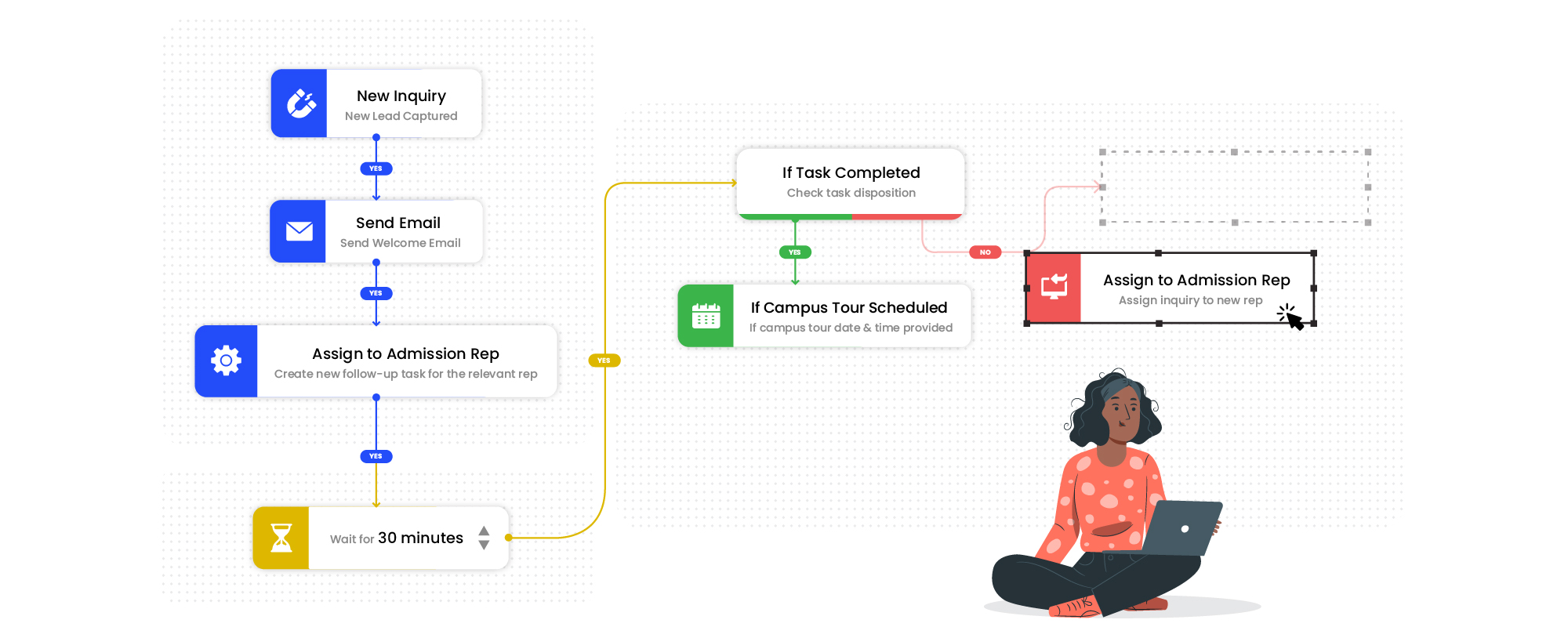
Armed with a prospective student’s contact information, you’ll use CRM to begin the lead nurturing process.
Use longtail and negative keywords
Longtail keywords are highly specific phrases targeting fewer—but more qualified—leads. For instance, “MBA program” will likely attract a higher volume than “Colleges in the Midwest with an MBA program,” with more general prospects. “Colleges in the Midwest with an MBA program” helps hone prospects interested in your specific location.
Also consider using negative keywords, which help filter out undesired traffic. For example, if you notice your keyword phrase “art schools in Canada” is also attracting job seekers, filter out the word “job.” Better targeting helps put ads in front of interested candidates and increase return on investment (ROI).
Google’s guide to negative keywords offers more details on how to implement them.
Optimize for mobile
In 2020, nearly 70% of web traffic globally came from mobile devices. To keep prospects engaged, higher ed marketers must adapt Google Ads for mobile.
Tips include:
- Evaluate mobile traffic in Google Ads by segmenting by device
- Adjust mobile bids
- Use proper Google extensions for mobile
- Ensure landing pages are mobile-friendly
For more, check out Google Ads’ guide to mobile optimization. Google highlights more key tips, as well as copywriting best practices.
Continuously evaluate performance
As campaigns run, closely monitor your ad’s performance. Six essential metrics to track include:
- Impressions
- Cost
- Clicks
- Click through rate (CTR)
- Conversions
- Cost per conversion
Set at least a weekly cadence for evaluation. Adjust ad copy, keywords, and bids to optimize conversions.
Gain deeper insights
For deeper performance insights, also gather data through Google Analytics. Use an Urchin Tracking Module (UTM) code to link your ad to the Google Analytics platform.
UTM codes track user engagement across different digital channels, allowing you to evaluate conversions. UTM codes are free to create through Google’s Campaign URL Builder, which generates codes based on user-submitted criteria.
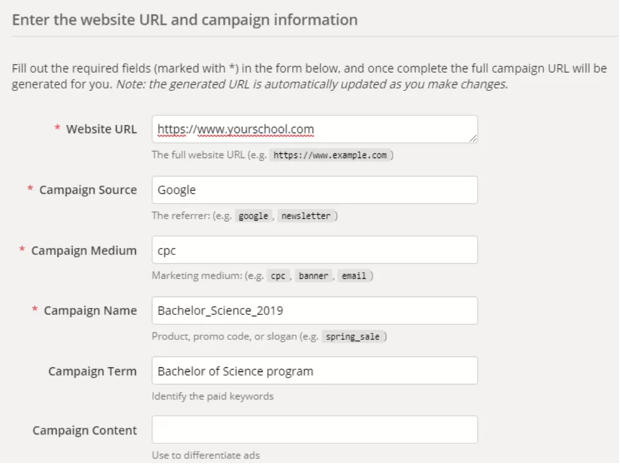
For a sense of what UTM parameters you’ll need, check out this snapshot of UTM creation in Google’s Campaign URL Builder by Higher Education Marketing Solutions.
Google Ads for education is an essential marketing tool for attracting new prospective students. Used in concert with organic content, Google Ads help drive hard-to-score conversions and elevate enrollment marketing.
FAQs
How much does it typically cost to run Google Ads campaigns for educational institutions?
Costs can vary significantly. Factors like campaign goals, target audience size, geographic location, and chosen keywords all impact cost. Research average cost-per-click (CPC) for relevant keywords in the education sector and set realistic budget expectations based on your specific needs.
How can educational institutions ensure their Google Ads reach the right prospective students?
Utilize Google Ads’ targeting options strategically. Target by demographics like age, location, and interests relevant to your ideal student profile. Consider layering on behavioral targeting to reach users who have previously shown interest in education or similar programs. Refine your targeting based on campaign performance data to optimize reach and maximize return on investment (ROI).
How can educational institutions measure the success of their Google Ads campaigns and track their impact on student enrollment?
Track key performance indicators (KPIs) like website traffic, click-through rates, and lead generation. Integrate Google Ads with website analytics tools to understand how ad clicks translate into website visits and potential student inquiries. Utilize conversion tracking to measure how many ad clicks convert into actual student applications or enrollments. This data allows you to measure campaign effectiveness and ROI, and adjust strategies for continuous improvement.





